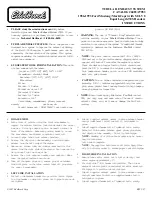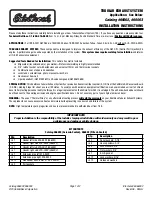
INTRODUCTION
PRELIMINAR STUDIES AND CONSIDERATIONS
MAINTENANCE AND DAMAGE PREVENTION
WORK ON BASIC VEHICLE
MOUNTING AND CONSTRUCTION
POWER TAKE-OFF
ELECTRIC AND ELECTRONIC SYSTEMS
APPENDIX
124
Body Builder Manual Part II, Specific Book LCV
V1.0, February 2015
According to Directive 70/221/EEC, a vehicle that has a distance greater than 550
mm from the rear end of the chassis frame or the end of the body to the ground
needs to have a rear underride guard installed.
For this reason, certain requirements and recommendations must be followed:
- Effective underride protection should be provided across the entire width of
the vehicle.
- The protection shall have the approval nameplate near the device itself.
- Lighting and licence plate should not be either fully or partially covered by the
device.
- Resistance of the mounting elements and mounting procedure will be checked
according to the directive.
- When the vehicle is unloaded, the lower edge of the underride guard must not
exceed 550 mm (A) from the road level.
- The horizontal distance between the last rear end of the vehicle and the rear
edge of the underride guard should not be higher than 400 mm (B). If the
wheelbase is modified, the underride guard must be relocated using the same
method as was used for the original position, and resistance and proper per
-
formance must be ensured.
- The height of the cross section of the underride guard should not be less than
100 mm (C).
NOTICE
- Sometimes, due to the installation of special equipment such as a rear tail lift, it
might be necessary to modify the structure of the underride guard. This oper
-
ation must not modify the original characteristics of resistance and stiffness.
- If the rear underride guard has been modified, it is necessary to submit certif
-
icates and documentation to the competent authorities, to validate the ade
-
quacy of existing modified device according to the regulations.
WARNING
Incorrect height or insufficient rigidity of the underride guard will mean that it will
not be able to prevent a car from slipping under the vehicle in the event of a
crash. This will cause serious damage to the car interior, with the consequent risk
to the occupants.
















































